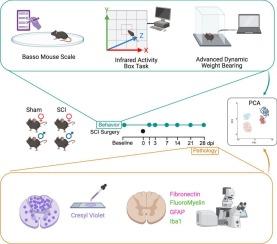Integrating sensitive motor tasks with histopathology detects sex differences in recovery after spinal cord injury
IF 4.2
2区 医学
Q1 NEUROSCIENCES
引用次数: 0
Abstract
Biological sex governs a myriad of molecular, cellular, and physiological features of the intact and injured nervous system. In traumatic spinal cord injury (SCI), biological sex is thought to influence functional recovery and tissue pathology. However, the open-field Basso Mouse Scale (BMS) used to track experimental SCI recovery relies on observer-based non-parametric scoring, which may not be sensitive enough to detect sex differences in motor behavior. Here, we tested whether two additional behavioral tasks – the infrared activity box and advanced dynamic weight bearing (ADWB) – identify any sex differences in motor recovery in male and female mice following a 70 kilodyne contusion SCI or sham (laminectomy) surgery. We then integrated data from these tasks with BMS scores, lesion area, myelin sparing, fibrosis, macrophage presence, and astrogliosis, using principal component analysis (PCA). BMS data were not different between sexes. However, the infrared activity box detected sex differences in both sham and SCI groups, with male mice spending more time making ambulatory bouts, and female mice spending more time performing stereotypic behaviors (e.g., grooming, sniffing). ADWB also detected sex differences in SCI, with male mice placing more weight on their hind end and abdomen, and females placing more weight on their fore paws. Histological analysis showed that male SCI lesions have more myelin loss than female SCI lesions, though several other readouts did not reach statistical significance. However, reducing multivariate behavioral and histopathological data into principal components stratified mice based on their surgical group and sex, with females scoring higher on the PCA-generated “Stereotypy, front paw weight-bearing and tissue preservation” index. Together, these data show that integrating multiple quantitative and observer-independent behavioral tasks with histopathology data increases sensitivity to detect sex differences in SCI.

将敏感运动任务与组织病理学相结合,检测脊髓损伤后恢复的性别差异。
生理性别支配着完整和受伤的神经系统的无数分子、细胞和生理特征。在创伤性脊髓损伤(SCI)中,生物性别被认为影响功能恢复和组织病理。然而,用于跟踪实验性SCI恢复的open-field Basso Mouse Scale (BMS)依赖于基于观察者的非参数评分,这可能不够敏感,无法检测运动行为的性别差异。在这里,我们测试了两个额外的行为任务——红外活动箱和先进的动态负重(ADWB)——是否能识别在70千瓦挫伤SCI或假(椎板切除术)手术后雄性和雌性小鼠运动恢复的性别差异。然后,我们使用主成分分析(PCA)将这些任务的数据与BMS评分、病变面积、髓磷脂保留、纤维化、巨噬细胞存在和星形胶质细胞形成相结合。BMS数据没有性别差异。然而,红外活动箱检测到假手术组和脊髓损伤组的性别差异,雄性小鼠花更多的时间进行走动,而雌性小鼠花更多的时间进行刻板行为(如梳理、嗅闻)。ADWB还发现了SCI的性别差异,雄性小鼠将更多的重量放在它们的后端和腹部,而雌性小鼠将更多的重量放在前爪上。组织学分析显示,男性脊髓损伤比女性脊髓损伤有更多的髓磷脂损失,尽管其他几个读数没有达到统计学意义。然而,将多变量行为和组织病理学数据纳入主要成分,根据手术组和性别对小鼠进行分层,雌性小鼠在pca生成的“刻板印象、前爪负重和组织保存”指数上得分更高。总之,这些数据表明,将多个定量的、与观察者无关的行为任务与组织病理学数据相结合,可以提高检测脊髓损伤性别差异的灵敏度。
本文章由计算机程序翻译,如有差异,请以英文原文为准。
求助全文
约1分钟内获得全文
求助全文
来源期刊

Experimental Neurology
医学-神经科学
CiteScore
10.10
自引率
3.80%
发文量
258
审稿时长
42 days
期刊介绍:
Experimental Neurology, a Journal of Neuroscience Research, publishes original research in neuroscience with a particular emphasis on novel findings in neural development, regeneration, plasticity and transplantation. The journal has focused on research concerning basic mechanisms underlying neurological disorders.
 求助内容:
求助内容: 应助结果提醒方式:
应助结果提醒方式:


